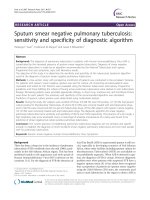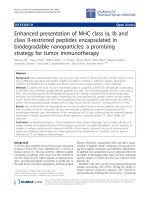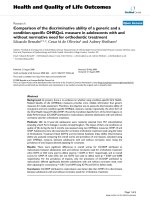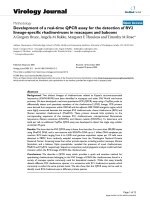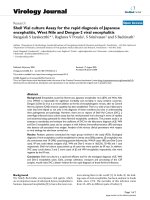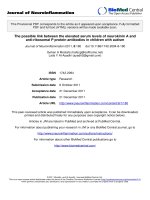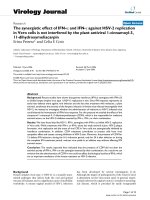Detection of sensitivity and specificity of line immuno assay in comparison with indirect immunofluorescence assay for the detection of anti-nuclear antibodies in diagnosis of systemic
Bạn đang xem bản rút gọn của tài liệu. Xem và tải ngay bản đầy đủ của tài liệu tại đây (279.02 KB, 6 trang )
Int.J.Curr.Microbiol.App.Sci (2018) 7(11): 743-748
International Journal of Current Microbiology and Applied Sciences
ISSN: 2319-7706 Volume 7 Number 11 (2018)
Journal homepage:
Original Research Article
/>
Detection of Sensitivity and Specificity of Line Immuno Assay in
Comparison with Indirect Immunofluorescence Assay for the Detection of
Anti-Nuclear Antibodies in Diagnosis of Systemic Autoimmune Disorders
Jabeen Begum*, V.V. Shailaja and Rajeshwar Rao
Department of Microbiology, Gandhi Medical College, Secunderabad, Telangana, India
*Corresponding author
ABSTRACT
Keywords
Systemic Autoimmune
diseases, Antinuclear
antibody test, Indirect
immunofluorescence
Assay, Line
Immunoassay
Article Info
Accepted:
07 October 2018
Available Online:
10 November 2018
Systemic autoimmune diseases (SAD) are the diseases where multiple organs are involved
in the presence of a large variety of auto antibodies directed against sub-cellular structures
or molecules (E.g. nuclei, cytoplasm, mitochondria, DNA) and are characterized by
presence of Antinuclear antibodies (ANA). Indirect immunofluorescence Assay (IIFA) on
Hep-2 (human epithelial cell tumour line) is a classical technique for detection of ANA
and is considered as “gold standard”. Though positive fluorescence pattern on IIFA
indicates the presence of ANA, however it does not allow precise identification of these
antibodies. For this specialized techniques like ELISA, western blotting or line
immunoassay (LIA) are employed 1) To detect sensitivity and specificity of Line immuno
assay (LIA) in comparison with Indirect immunofluorescence assay(IIFA) for the
detection of anti-nuclear antibodies in diagnosis of systemic autoimmune disorders. A
cross-sectional study was conducted and a total of 150 clinically suspected cases of SAD
of both sexes and above 18yrs of age from various departments were included in the study
and blood samples collected were subjected to Indirect Immunofluorescence test on Hep-2
cells coated slides and Line immunoassay. 150 samples were analyzed for ANA by IIFA
and LIA. Out of 150 samples, 54 samples were positive by IIFA. Line immunoassay was
positive in 49 samples. Sensitivity and Specificity of LIA was found to be 72.2% and
89.58% respectively. Positive Coincidence Rate came out to be 79.59%. In contrast to
other studies, our study gave an apt correlation of ANA detection by Line Immuno Assay
and indirect immunofluorescence assay.
Introduction
Autoimmune disease is characterized by tissue
injury due to breakdown of one or more of the
basic mechanisms regulating immune
tolerance leading to immunological reaction of
the organism against its own tissues.
Autoimmune diseases may occur as an
isolated event (organ specific) or as systemic
(non organ specific) autoimmune disease.
Systemic autoimmune diseases are the
diseases where multiple organs are involved in
the presence of a large variety of auto
antibodies directed against sub-cellular
structures or molecules. (Eg:- nuclei,
cytoplasm, mitochondria, DNA). Diseases in
this group includes Systemic lupus
erythematosis
(SLE),
Systemic
743
Int.J.Curr.Microbiol.App.Sci (2018) 7(11): 743-748
sclerosis/Scleroderma (SSc), undifferentiated
connective tissue diseases or Mixed
Connective
tissue
diseases
(MCTD),
Dermatomyositis /Polymyositis, Sjogren’s
syndrome (SS/SjS) (Jacinth Angel et al.,
2015). Systemic autoimmune disorders are
characterized by presence of Antinuclear
antibodies (ANA) in the blood of patients.
ANA are a specific class of autoantibodies
that have the capability of binding and
destroying certain structures within the
nucleus of the cells and are considered to be a
serological hallmark of connective tissue
diseases (Minz et al., 2012).
Inclusion criteria
The American College of Rheumatology
(ACR) stated that ANA detection by IIFA on
Hep-2 cells is considered as the gold standard
(Damoiseaux and Cohen Tervaert, 2006) In a
Clinically suspected cases of connective tissue
disorders, ANA test is done, if positive further
tests like Line immunoassay, ELISA, western
blotting etc. are performed for the diagnosis of
specific systemic autoimmune diseases. If
negative no further autoantibody testing is
performed (Alvarez et al., 1999; Kavanaugh
and Solomon, 2002).
Sample size and duration of the study
The present study was carried out to compare
Indirect Immunofluorescence test (GOLD
STANDARD) with line immunoassay
Approval of the Institute’s ethical committee
was obtained to carry out the study
Materials and Methods
Clinically suspected cases of Systemic
autoimmune diseases of >18yrs of age and
both sexes.
Exclusion criteria
Patients other than Systemic autoimmune
diseases
Patients with Systemic autoimmune diseases
with co-existing infectious diseases or
carcinoma.
150 Blood samples of suspected cases of
systemic autoimmune diseases and over a
period of 1 year
From June 2016 to June 2017, 150 blood
samples from clinically suspected cases of
Systemic autoimmune disease patients
attending both outpatient and inpatient of
Gandhi hospital, Secunderabad, referred to
microbiology laboratory for Anti-Nuclear
Antibodies (ANA) were included in study.
Under aseptic precautions 3ml of Blood
samples collected, Serum separated out,
alliquoted and stored in -20⁰ C.
Repeated thawing is avoided. Samples and kit
reagents are brought to room temperature 30
minutes before procedure
Study design: Cross-sectional study
Antinuclear antibodies (ANA) detection by
indirect immunofluorescence test is done
using The Immuno Concepts HEp-2000®
ANA Test System with transfected mitotic*
human epithelioid cells (HEp-2 cells coated
slides) and
Study period: 12 months (JUNE 2016- JUNE
2017)
All samples are further evaluated by line
immunoassay (LIA)
Settings
Study Place: Department of Microbiology,
Gandhi Medical College, Secunderabad
744
Int.J.Curr.Microbiol.App.Sci (2018) 7(11): 743-748
Methods
Collected blood sample were brought to the
laboratory and serum was separated using the
standard protocol of the laboratory. IIFA was
performed using The Immuno Concepts ANA
Test System with mitotic human epithelioid
cells (HEp-2) represents an advanced
immunofluorescent system for detection of
ANA. HEp-2 cells with mitotic figures have
been shown to have greater sensitivity and
yield sharper pattern recognition than classical
mouse kidney substrate in detecting antibodies
in progressive systemic sclerosis.
Positive and Negative controls were run with
each test daily. Serum was diluted in 1:80
ratio (serum: diluent) (10 μl serum +790 μl
diluent). 30 μl of the diluted serum was then
put on each wells. This was then incubated at
room temperature for 30 min. This step
allowed the antibodies in the serum to react
with the antigens coated on the wells.
The slide (wells) was then washed carefully
and then dipped into the PBS for 10 min to
remove the unbound antibodies. In the next
step, FITC conjugate (Anti-human IgG
conjugated to fluorescein isothiocyanate
(FITC) was added to wells, to get bound to the
antibodies and emit fluorescence. The FITC
was again washed off carefully and dipped in
PBS (in dark) for 10 min, to remove the
unbound conjugate. The wells were then
mounted using mounting medium. The
visualization of the slide was then done under
the fluorescence microscope at 40X. Based on
the fluorescent intensity, samples were graded
(+, ++, +++) and NEGATIVE.
Negative
A serum was considered negative for
antinuclear antibodies if nuclear staining was
less than or equal to the negative control well
with no clearly discernible pattern. The
cytoplasm may demonstrate weak staining,
with brighter staining of the non-chromosomal
region of mitotic cells, but with no clearly
discernible nuclear pattern.
Positive
A serum was considered positive if the
nucleus shows a clearly discernible pattern of
staining in a majority of the interphase cells.
The positive sample showed bright apple
green fluorescence in the nuclei of the cells,
with a clearly discernible pattern characteristic
of the control serum that was used. The serum
samples which were positive or negative by
IFA method were further processed using Line
Immuno Assay (LIA) using IMTEC-ANALIA MAXX kit. To perform LIA, nitro
cellulose strips coated with 17 highly purified
antigens as discrete lines (nRNP/Sm, SSA,
Ro-52, SSB, Scl-70, PM-Scl, Jo-1, CENP-B,
dsDNA, Nucleosomes, Histones, Ribosomal
P-protein, AMA-M2) were used along with
control band. The test procedure was as
follows: Serum was diluted using DILUTION
BUFFER in 1:110 and left on the horizontal
shaker for 30 min. After this, 3 x washing was
done with the WASH SOLUTION for 5 min
each. This was then followed by adding
CONJUGATE to the strip for 30 min. Again
the washing step was repeated. To the washed
strip, SUBSTRATE was added and left for 10
min. Afterwards, the reaction was stopped by
adding STOP SOLUTION for 2 min. Then the
strips were dried and evaluated by comparing
with the intensity of Positive Control Line.
Results and Discussion
A Total of 150 samples of clinically suspected
cases of Systemic autoimmune diseases from
various Departments of Gandhi Hospital,
Secunderabad, are included in the study.
Antinuclear antibody (ANA) detection done
by Indirect Immunofluorescence Assay (IIFA)
and Line immunoassay (LIA) (Table 1 and 2).
745
Int.J.Curr.Microbiol.App.Sci (2018) 7(11): 743-748
Fig.1 Results with ANA-IIFA and line immunoassay tests in the study population
Table.1 Comparison between ANA detection by IIFA (Gold standard) and LIA
TEST
POSITIVE
BY LINE IMMUNO
ASSAY(LIA)
NEGATIVE
TOTAL
ANA DETECTION BY INDIRECT
IMMUNOFLUORESECENT TEST(IIFA)
POSITIVE
NEGATIVE
39
10
(True positive)a
(False positive) c
15
86
(False negative)b
(True Negative)d
54 (a+b)
96 (c+d)
TOTAL
49
(a+c)
101
(b+d)
150
Table.2 Sensitivity and specificity of line immunoassay in comparison with IIFA
Statistic
Sensitivity
Formula
Value
72.22%
Specificity
89.58 %
Disease prevalence
36.00%
Positive Coincidence value
79.59%
Negative Coincidence value
85.15 %
Total number of samples with ANA-IIFA and
line immunoassay done: 150
Number of samples with ANA-IIFA positive
with line immunoassay negative: 15
Number of samples with ANA-IIFA positive
with line immunoassay positive: 39
Number of samples with ANA-IIFA negative
with line immunoassay positive: 10
746
Int.J.Curr.Microbiol.App.Sci (2018) 7(11): 743-748
how to proceed?” Autoimmunity
Reviews, vol. 5, no. 1, pp. 10–17, 2006
Jacinth Angel, Marin Thomas, Boppe
Appalaraju
(2015)
cited
2017
Evaluation of ELISA and indirect
Immunofluorescence in the diagnosis of
autoimmune
diseases
and
their
interpretation in the clinical situation
Department of Microbiology, PSG
Institute of Medical Sciences and
Research, Coimbatore, Tamil Nadu,
India J Acad Clin Microbiol 17:7-11.
DOI: 10.4103/0972-1282.158776
Kavanaugh, A. F., and D. H. Solomon, and
The
American
College
of
Rheumatology ad hoc Committee on
Immunologic
Testing
Guidelines,
“Guidelines for immunologic laboratory
testing in the rheumatic diseases: antiDNA antibody tests,” Arthritis Care and
Research, vol. 47, no. 5, pp. 546–555,
2002
Madhavi Latha B, and Anil Kumar B (2014)
Detection of antinuclear antibodies by
indirect immunofluorescence method
and its comparison with line
immunoassay in a tertiary care hospital:
A laboratory based observational study.
J Med Sci Res 2(4):194-199
10.17727/JMSR.2014/2-034
Manas Akmatov et al., Arthritis Research &
Therapy
(2017)
19:127
DOI
10.1186/s13075-017-1338-5
Minz RW, Kumar Y, An and S, et al., (2012)
Antinuclear
antibody
positive
autoimmune disorders in North India:
an appraisal. Rheumatol Int. 2012;
32:2883–2888.
Sarojini Raman, Amit Kumar Adhya, Prasant
kumar Pradhan, Kanaklata Dash,
Urmila Senapati (2017) Correlation of
Indirect Immunofluorescence & Line
Immunoassay Method in Detection of
Autoimmune
Diseases:
an
Observational Study at a Tertiary Care
Number of samples with ANA-IIFA negative
with line immunoassay negative: 86
In the current study, comparing LIA with the
gold standard IIFA, the sensitivity of LIA was
found to be 72.22% and specificity was
89.58%. Positive coincidence value was
79.59%. Prevalence of disorder found to be
36%.
In the present study, sensitivity and specificity
of LIA was found to be 72.2% and 89.58%
which is correlating with other studies like
Sarojini Raman et al., (2017), Sharmin et al.,
(2014), Madhavi Latha and Anil Kumar
(2014), Wendy Sebastine et al., (2016)
Prevalence of ANA was found to be 36% in
present study which is also correlating with
other studies of Sarojini Raman et al., (2017),
Shaily Garg et al., (2017), Wendy Sebastine
et al., (2016), Akmatov et al., (2017). Positive
coincidence value was 79.59% correlating
with Sarojini Raman et al., (2017), Sharmin et
al., (2014), Wendy Sebastine et al., (2016).
As the prevalence of Systemic autoimmune
diseases is increasing there is a need for early
and accurate diagnosis for prompt initiation of
treatment to reduce disease morbidity and
mortality, Hence detection of ANA by
Indirect immunofluorescence test followed by
profiling of Antinuclear antibodies by Line
immunoassay will help in early and accurate
diagnosis of systemic autoimmune diseases.
References
Alvarez, F., P. A. Berg, F. B. Bianchi et al.,
(1999)
“International
autoimmune
hepatitis group report: review of criteria
for diagnosis of autoimmune hepatitis,”
Journal of Hepatology, vol. 31, no. 5,
pp. 929–938, 1999.
Damoiseaux, J. G. M. C. and J.W. Cohen
Tervaert, (2006) “From ANA to ENA:
747
Int.J.Curr.Microbiol.App.Sci (2018) 7(11): 743-748
Teaching Hospital Sch. J. App. Med.
Sci., 2017; 5(7A):2520-252
Shaily Garg, Anshika Srivastava* and
Santosh Prasad (2017): Correlation of
Line Immuno Assay with Indirect
Immunofluoresence Assay for the
Detection of Anti-Nuclear Antibodies in
Various
Autoimmune
Disorders;
Journal of Autoimmune Disorders,
Vol.3 No.3:37 2017
Sharmin S, Ahmed S, Abu Saleh A, Rahman
F, Choudhury MR, Hassan MM (2014)
Association of Immunofluorescence
pattern of Antinuclear Antibody with
Specific
Autoantibodies
in
the
Bangladeshi Population Bangladesh
Med Res Counc Bull 2014; 40: 74-78
Wendy Sebastian, Atanu Roy, Usha Kini,
Shalini Mullick (2016) Correlation of
antinuclear
antibody
immunofluorescence patterns with
immune profile using line immunoassay
in the Indian scenario Indian Journal Of
Pathology And Microbiology - 53(3),
July-September
2010
DOI:
10.4103/0377-4929.68262
How to cite this article:
Jabeen Begum, V.V. Shailaja and Rajeshwar Rao. 2018. Detection of Sensitivity and
Specificity of Line Immuno Assay in Comparison with Indirect Immunofluorescence Assay for
the Detection of Anti-Nuclear Antibodies in Diagnosis of Systemic Autoimmune Disorders.
Int.J.Curr.Microbiol.App.Sci. 7(11): 743-748. doi: />
748

